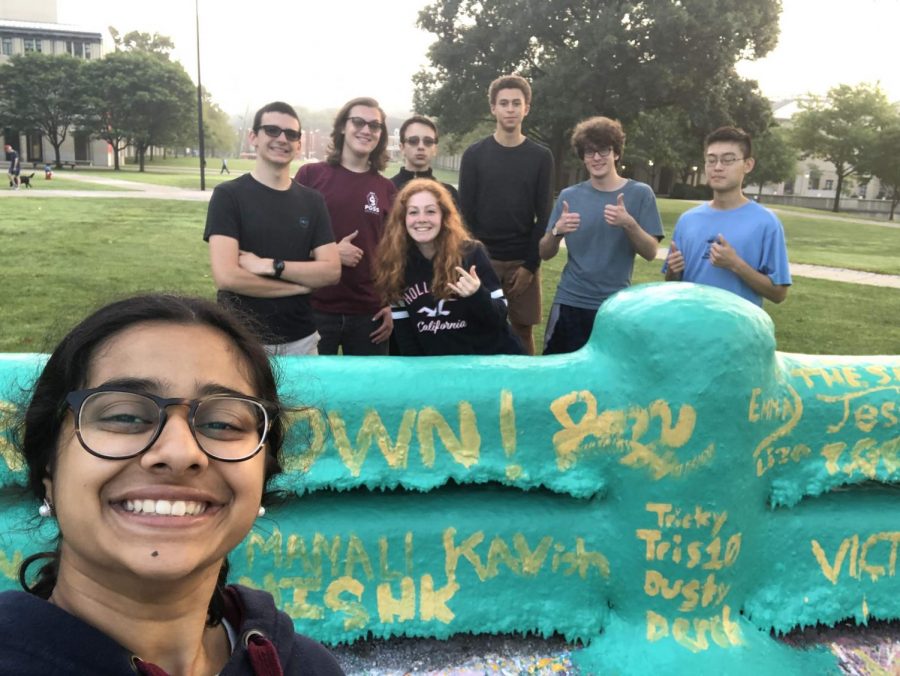Five weeks to never forget
How PGSS gave me a once in a lifetime experience
The night before we left, we painted the famous Fence at CMU. The morning after, a few of us went out to breakfast and stopped by the Fence to take a picture after the paint had mostly dried.
If I was asked “If you could go back and change one thing you’ve done, what would it be?” I would know for sure what my answer would not be: applying to PGSS. Pennsylvania’s Governor’s School for the Sciences (PGSS) is a five week STEM summer program at Carnegie Mellon University (CMU) in Pittsburgh, where high school juniors from across Pennsylvania apply to get in.
When my mother first told me about the program, I knew it was something I wanted to apply for. The application opened in the fall and was due in late January. The application was similar to that for a college — personal information, achievements, essays, test scores, grades and letters of recommendation. Though the application was time-consuming, it was definitely worth the time.
Though the applicants were informed that they would be getting their decisions back in early April, it felt like they would never come. March 31 was one of my proudest and most exciting moments: I had been accepted into PGSS. Later I would find out the program had over 400 applicants and I was one of 56 who had made it into the program.
The program lasts for 35 days; this year from move-in day on June 30 to move-out day on August 3. Between those days, students would be living on campus at Hamerschlag House, one of the residence halls located at CMU. Every student was assigned a roommate and their floor.
On move-in day, all of us “govies” (PGSS students) were taught the rules and had icebreaker activities, as we were all from different parts of the state. The activities were run by our Residence Life Directors and Teaching Assistants, who were all students at various colleges.
Every weekday, we had core classes from 8 a.m. to 12:30 p.m. These classes were in computer science, Discrete Math, molecular biology, Organic Chemistry and physics. For each class, we would receive a homework assignment that was due on a different day of the week (e.g.. Physics on Wednesday, Biology on Thursday). All of these classes were taught at a college level, so they were more difficult than what you would typically find in a high school course.
These classes were taught in a regular manner. The teacher would lecture for 50 minutes with students asking questions through the class. Every teacher had their own style of teaching, and I enjoyed all of them.
One of the main points of the program is that there are no grades. This means there is zero competition between the students when it comes to grades. Instead, a letter is constructed based on feedback from the teachers and staff, which the student would receive after the program ends. Govies can use this letter as a supplement to their college applications.
When working on the homework, it was difficult to do it by yourself. Oftentimes the topics would extend outside what we had gone over in class. Though still possible to figure out the problems, I found working with others and receiving help from the Teaching Assistants helped me to gain a greater understanding of the content. Any time we missed a problem on the homework, we would get a “re-do” and do that problem again until we got it correct.
On top of core classes, we had the option of choosing up to three electives. I chose the laser, Higgs Boson and geometry electives. Other offered electives were in music, chemistry and neurology. These took place later in the day, after lunch and dinner.
Alongside these courses, everyone picked a lab course and a team project. For the lab, we had options of Computer Science, Biology, Physics and Chemistry. I chose the physics lab, where we did work with optics, the speed of sound, superconductors and other physics-related labs. For team projects, there was a wide variety for every offered core subject, but I settled on the mathematical physics project that revolved around Chaos and the Duffing Oscillator.
Every evening, a different social activity was planned to help relieve stress from us students. All of them were fun, but some of them were different from what I’m used to. For instance, the first Monday I was there, we had square dancing and later on in the month we had “Tour de Donut”—a relay race where each leg had to progressively eat more donuts. There is no doubt looking back that these events added so much character to the entire program.
At the end of the five weeks, we had two major events: the Scientific Symposium and the banquet. At the Symposium, each Team Project presented the research they had done over the past few weeks and answered questions from the audience. At the banquet, each student was awarded with a certificate of completion that contained Governor Tom Wolf’s signature.
For the final night of the program, we didn’t have a curfew and we painted “The Fence.” Every govie put their name on one side and their handprint on the other. Even if the paint chips away in the future, the memories I made then won’t. A few of us stayed up all night and waited for the sunrise over Pittsburgh.
There is nothing about the experience I would change; I thoroughly enjoyed my time in the program and I would highly recommend it to anyone that is willing to give the program a try. I made many friends and memories that I will never forget. On top of that, I feel more prepared for my future, no matter what it may hold for me, and it’s all thanks to the amazing opportunity PGSS gave me.



